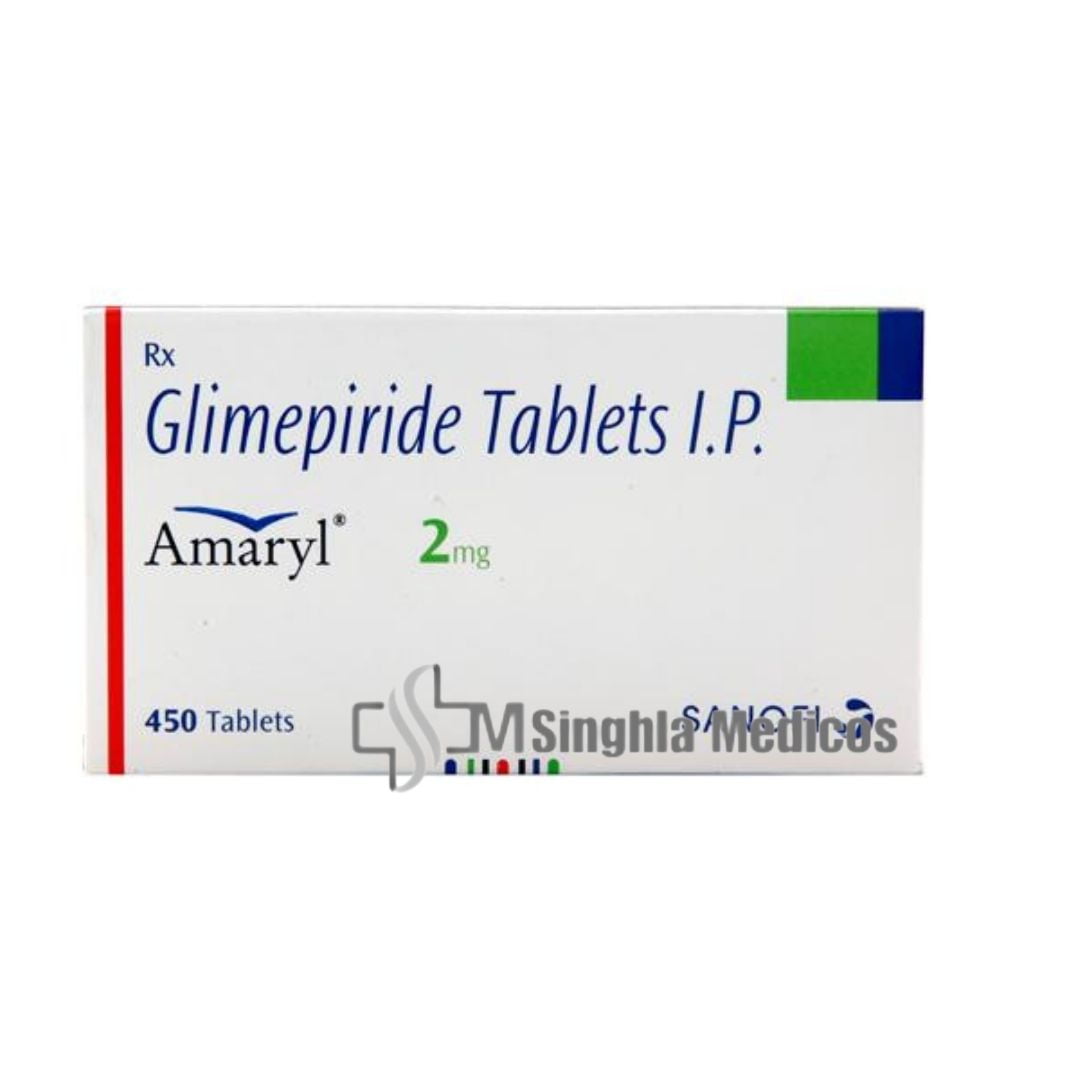

Amaryl 2mg Tablet
₹194.54 Original price was: ₹194.54.₹175.09Current price is: ₹175.09.
![]() Prescription Required
Prescription Required
Salt : Glimepiride (2mg)
Manufacturer : Sanofi India Ltd
Packing : 30 tablets in 1 strp
PRODUCT INTRODUCTION
Amaryl 2mg Tablet is a medication primarily prescribed for the management of type 2 diabetes mellitus. Each tablet contains 2 milligrams of the active ingredient glimepiride, a sulfonylurea compound. Glimepiride works by stimulating the release of insulin from the pancreas, thereby helping to lower blood sugar levels in individuals with diabetes. This oral medication is available in tablet form and is typically taken once daily, preferably with breakfast or the first main meal of the day. It is important to use Amaryl 2mg Tablet as directed by a healthcare professional and to adhere to any accompanying lifestyle modifications, such as diet and exercise, to achieve optimal diabetes management.
USES OF AMARYL 2MG TABLET
Amaryl 2mg Tablet is primarily indicated for the treatment of type 2 diabetes mellitus, a chronic condition characterized by insulin resistance and high blood sugar levels. It is used to help control blood sugar levels in individuals whose diabetes cannot be adequately managed through lifestyle modifications alone, such as diet and exercise. This medication is often prescribed when diet and exercise alone are insufficient or when other oral antidiabetic medications have not provided adequate glycemic control. Amaryl 2mg Tablet may be used alone or in combination with other antidiabetic medications, such as metformin, to achieve optimal blood sugar control in patients with type 2 diabetes.
BENEFITS OF AMARYL 2MG TABLET
Amaryl 2mg Tablet offers several benefits in the management of type 2 diabetes mellitus:
- Blood Sugar Control: By stimulating insulin release from the pancreas, Amaryl helps to lower blood sugar levels, thereby reducing the risk of hyperglycemia-related complications.
- Improved Glycemic Control: Amaryl can help individuals with type 2 diabetes achieve and maintain target blood sugar levels, which is essential for preventing long-term complications such as cardiovascular disease, neuropathy, and kidney damage.
- Convenience: Amaryl is available in tablet form and is typically taken once daily, making it a convenient option for many patients.
- Flexibility: Amaryl can be used alone or in combination with other antidiabetic medications, providing flexibility in treatment options to suit individual patient needs.
- Reduced Risk of Hypoglycemia: Compared to some other antidiabetic medications, Amaryl has a lower risk of causing hypoglycemia (low blood sugar), especially when used at the appropriate dose.
SIDE EFFECTS OF AMARYL 2MG TABLET
While Amaryl 2mg Tablet is generally well-tolerated, like all medications, it may cause side effects in some individuals. Common side effects of Amaryl may include:
- Hypoglycemia: The most common side effect of Amaryl is hypoglycemia, or low blood sugar. Symptoms may include shakiness, dizziness, sweating, confusion, and hunger. It is important for patients taking Amaryl to monitor their blood sugar levels regularly and to be aware of the signs and symptoms of hypoglycemia.
- Weight Gain: Some individuals may experience weight gain while taking Amaryl. This side effect may be more pronounced in some patients than others.
- Gastrointestinal Symptoms: Amaryl may cause gastrointestinal side effects such as nausea, vomiting, diarrhea, or constipation in some individuals.
- Allergic Reactions: Although rare, some people may experience allergic reactions to Amaryl, which may manifest as rash, itching, swelling, or difficulty breathing. If any signs of an allergic reaction occur, medical attention should be sought immediately.
- Liver Function Abnormalities: In rare cases, Amaryl may affect liver function, leading to abnormalities in liver enzyme levels. Regular monitoring of liver function may be recommended for some patients.
References
-
Powers AC, D’Alessio D. Endocrine Pancreas and Pharmacotherapy of Diabetes Mellitus and Hypoglycemia. In: Brunton LL, Chabner BA, Knollmann BC, editors. Goodman & Gilman’s: The Pharmacological Basis of Therapeutics. 12th ed. New York, New York: McGraw-Hill Medical; 2011. pp. 1255-1257.
-
Nolte MS. Pancreatic hormones and antidiabetic drugs. In: Katzung BG, Masters SB, Trevor AJ, editors. Basic and Clinical Pharmacology. 11th ed. New Delhi, India: Tata McGraw Hill Education Private Limited; 2009. pp. 740.
-
Briggs GG, Freeman RK, editors. A Reference Guide to Fetal and Neonatal Risk: Drugs in Pregnancy and Lactation. 10th ed. Philadelphia, PA: Wolters Kluwer Health; 2015. pp. 629-30.
Disclaimer
Singhla Medicos primary intention is to ensure that its consumers get information that is reviewed by experts, accurate and trustworthy. The information and contents of this website are for informational purposes only. They are not intended to be a substitute for professional medical advice, diagnosis, or treatment. Please seek the advice of your doctor and discuss all your queries related to any disease or medicine. Do not disregard professional medical advice or delay in seeking it because of something you have read on Singhla Medicos. Our mission is to support, not replace, the doctor-patient relationship.
Shipping Policy
We ship across India. Note – this is subject to change as per Company Wishes. Packages will be shipped in 24 working hours. we are closed on Sundays and will reach you in the next 2-4 days post shipping. We give the estimated time of delivery on the shipping page. However, these are indicative and depend on our shipping partner.
Delivery
The delivery times are subject to location, distance, and our logistics partners. We are not liable for any delays in delivery by the courier company/postal authorities but will help you track down a package through our partner courier services.
Your purchases may reach you from various locations in more than one package. But rest assured, you will be charged one delivery fee for the entire order. As soon as your package ships, we will email you your package tracking information.
We are bound in coverage by their reach even though we use some of India’s largest logistics companies for shipping. In case your address is in a location not served by them we would contact you to find an alternative solution to make your products reach you.












Reviews
There are no reviews yet.